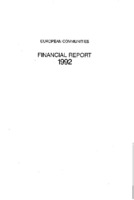| dc.contributor.author | Commision of the European Communities |
| dc.date.accessioned | 2020-06-21T13:26:50Z |
| dc.date.available | 2020-06-21T13:26:50Z |
| dc.date.issued | 1992 |
| dc.identifier.uri | https://ketlib.lib.unipi.gr/xmlui/handle/ket/2458 |
| dc.description | Sections are bookmarked. Blank pages have been removed. |
| dc.description | http://aei.pitt.edu/id/eprint/9650 |
| dc.description.abstract | Since the process of European integration began, there have been a number of major developments in the Community's financial system. Progress towards financial autonomy The European Coal and Steel Community was given financial autonomy from the outset with the introduction of a real Community levy. The process was completed in 1971 when own resources were introduced as a specific source of revenue for the Community to replace the system of financial contributions by the Member States set up under the Treaty of Rome in 1957. Development of common policies In view of the financial autonomy afforded to its common policies, the Community was able to pursue the objectives of European in-tegration. The establishment of the European Agricul-tural Guidance and Guarantee Fund in 1962 paved the way for a common agricultural policy, while expenditure on structural policies helped promote economic and social cohesion in the Community. For energy, industry, technology and research, Community spending acted as a catalyst for projects of common interest. Ex-penditure on cooperation with developing and other non-member countries reflected the Community's determination to be receptive to international problems. |
| dc.format.extent | 77p. |
| dc.language.iso | en |
| dc.publisher | Office for Official Publications of the European Communities |
| dc.subject | Budgets and Financing |
| dc.subject | Borrowing and Lending |
| dc.subject | Economic and Financial Affairs |
| dc.title | European Communities financial report 1992 |
| dc.type | working document |
| dc.publisher.place | Luxembourg |

